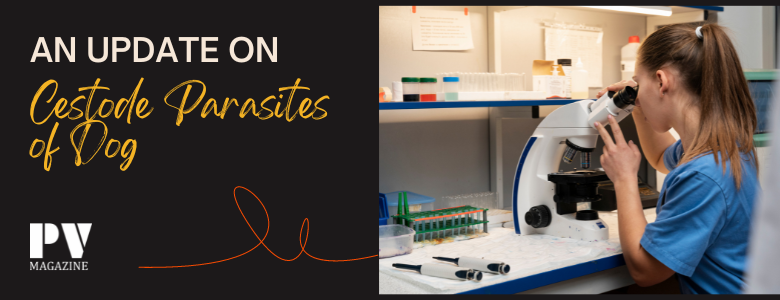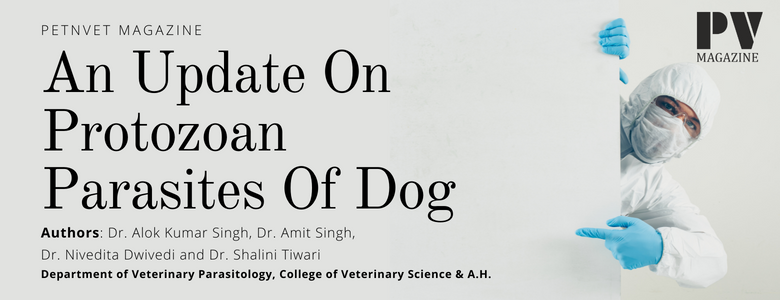Cestodes parasites of Dogs are elongated, tape-like with flat bodies without a body cavity (commonly called as tapeworms) and are hermaphrodite in nature. Generally cestode causes destruction in the host’s body by the mechanical obstruction, or by the pressure of growing size. It usually consists of head/scolex, unsegmented part i.e. neck, and strobila. Strobilas consist of immature, mature and gravid proglottids. Gravid proglottids carry mature eggs. Cestodes have an indirect life cycle by the involvement of except Hymenolepis nana. Metacestode or bladder worm is the larval stage of cestode and contains an infective stage for it.

Notable Cestodes Parasites of Dogs
- Dipylidium caninum
It is also known as a double pored tapeworm of dogs. Gravid and mature segments have a characteristic shape resembling cucumber seed-shaped and crawl out from the anus of the dog causing itching, anal pruritis, and dragging of the anus.
Clinical signs
- Diarrhea may occur within 2-3 days after infection.
- The affected animal shows weakness due to loss of electrolytes and abdominal pain.
- The dogs drag the anus over the ground because of itching and irritation.
Diagnosis
- By fecal examination, observe the egg capsule or eggs separate from the egg capsule, resembling cucumber seed-like.
- Observe typical clinical signs such as anal dragging over the ground.
Prevention and control
- Proper treatment of the affected animal as soon as early.
- Control of fleas and lice by using a suitable acaricide.
- Proper cleaning and washing of dog once in week or month as per required.
- Proper removal of lice from dog body.
- Deworming should be done at regular intervals.
- Avoid the mixing of the stray dogs with the housed pet.
2. Taenia pisiformis
It occurs in the small intestine of a dog. After developing larvae migrates into the peritoneal cavity. Rabbits act as an intermediate host.
3. Taenia Ovis
The cysticercus occurs in the muscles heart, diaphragm, and masseters. Intermediate hosts are sheep and goats.
4. Taenia serialis
Its distribution is cosmopolitan and lagomorphs act as an intermediate host. The coenurus serialis develops in intermuscular as well as subcutaneous connective tissue.
5. Taenia hydatigena
It is also known as a thin neck bladder worm. In this disease cysticercus forms in the liver and causes traumatic hepatitis.
6. Taenia multiceps
Gid is a clinical sign observed in the affected animal. Coenurus cerebralis parasites of dogs are found in intermediate host as metacestode. Intermediate hosts are sheep and goats.
Clinical signs
- Circling movement is a typical sign.
- Migratory oncosphere is dangerous and causes meningitis, encephalitis.
- Skulls may also get reduced in size and maybe soft.
- Sometimes animals move straight and until obstacle with a hard object.
Diagnosis
- Through clinical signs such as gid.
- The softness of the skull is felt if a finger is placed between horns.
- By fecal examination.
Prevention and control
- The cyst may be removed surgically when located on the surface of the brain.
- Avoid the ingestion of infected uncooked meat.
- Proper sanitation of kennel.
- Proper public education about sanitation.
- Treatment of affected animal at earliest.
- Proper cooking of meat before consumption.
- Provide ample quantity of clean water.
7. Echinococcus granulosus
The number of segments is less usually 3-4.It is generally found in liver and lungs of dogs. Ovaries are kidney-shaped. Hydatid cysts in different organs like lungs, liver etc.
8. Echinococcus multilocularis
Alveolar hydatid cyst due to resemblance of alveoli.The rodents act as an intermediate host.
9. Echinococcus Vogeli
The genital pore is situated posterior inside and lateral branches of uterus and is long as well as tubular. Hydatid cyst is developed in rodents.
Clinical signs
- It mostly occurs in the liver as well as lungs etc.
- Inflammation of the intestine in the dog may see.
- Pressure atrophy in vital organs due to the presence of large-sized cysts is found.
Diagnosis
- By examining the fecal sample.
- Diagnosis is done based on PM examination.
- Radiographic and ultrasound examination is helpful.
- Casoni’s test – hydatid cyst fluid is inoculated in suspected individuals.
Prevention and control
- Dogs should be retained from taking raw meat.
- Strict stray dogs on-premises.
- Regular checkups and treatment of dogs.
- Deworming done should be regularly.
- Avoid unhygienic water drinking.
- Treatment of affected dogs at the earliest.
- Avoid contamination and mixing of other suspected individuals.
- By controlling of intermediate host.
- Avoid defecation in open areas such as gardens, parks, and other grazing areas.
10. Diphyllobothrium latum
It is also known as fish tapeworm or broad tapeworm. The Head is spatula-shaped with a deep groove called bothria. It causes pernicious anemia due to deficiency of vitamin B12.
Diagnosis
- By observing clinical signs.
- AA fecal examination can be done to observe eggs.
- Examination of the anal swab may reveal the presence of a tapeworm.
Clinical signs
- Abdominal discomfort due to irritation caused by tapeworm.
- Nervous damage-causing disorders like an epileptic fit, running fit
- Initially, it causes intermittent diarrhea followed by constipation.
- Anemia occurs due to competition between host and parasites.
- If we examine the intermediate host, observe the damage with adhesion.
Prevention and control
- Undercooked fish or raw flesh should not be offered to dogs.
- Proper treatment of the infected dog.
- Proper sanitation of kennel and premises.
- Freezing of fishes can kill scolex of tapeworm.
- Proper decomposing of feces.
- Avoid the entry of stray dogs into the kennel.
- Proper treatment of intermediate host for spreading the diseases.
11. Spirometra mansoni
These parasites of dogs are found in the small intestine of dogs. The first intermediate host is copepod while, the second intermediate host is so many such as mice, mammals, birds etc. who ingest procercoid further development into the second larval stage i.e. plerocercoid and it referred as sparganum.
Diagnosis
- On the basis of the clinical sign.
- The immunodiagnostic test can be done.
- Proglottids can be identified microscopically
Clinical signs
- Pain and oedema is found in subcutaneous tissue.
Prevention and control
- Avoid undercooked fish for consumption.
- Avoid drinking contaminated water.
- Proper sanitation should be followed in the kennel as well as premises.
- Regular deworming should be done.
- The sick dog should be treated immediately.
- Educate the people about public health.






